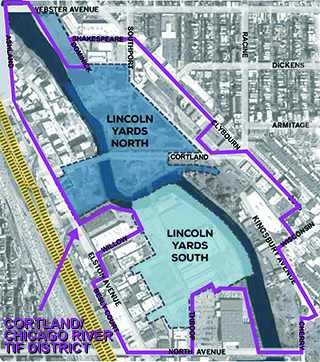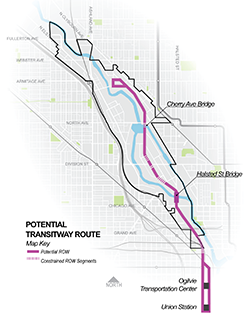For the past year, city approval of the proposed Lincoln Yards complex has run along two separate tracks.
In the first track, developer Sterling Bay applied for the rezoning of 55 acres along the Chicago River's North Branch, so it could build 14.5 million square feet of residences, offices, and retail in the formerly industrial area. Chicago's City Council approved that rezoning in the form of two ordinances on March 13.

Footprints of Lincoln Yards and the surrounding Cortland/Chicago
River TIF district. Source: city of Chicago. Illustration: Tim Ryan.
In the second track, the city of Chicago seeks to establish a tax-increment financing (TIF) district—about twice the size of Lincoln Yards—that would surround the development. The city wants the TIF district to fund public infrastructure such as streets and bridges that Lincoln Yards would need, paid for by diverting hundreds of millions of dollars in local property taxes away from schools, parks, and county services.
While passage of the Lincoln Yards rezoning ordinances gives Sterling Bay a green light to apply for building permits, city officials have said that Lincoln Yards will not be built without public subsidy—in the form of TIF—for the rehab and addition of streets, bridges, water lines, sewers, transit, and lighting. So public focus now moves to approval of the TIF district, known in city parlance as the Cortland and Chicago River Redevelopment Project Area.
Mayor Rahm Emanuel's administration wants the City Council to approve the TIF district before Emanuel leaves office in May.
Such approval would come as the passage of two new ordinances:
- The first ordinance (O2019-2185) defines the TIF district's boundaries, lets the city stockpile expected increases in property taxes, and adopts the 85-page redevelopment plan crafted by the city's Dept. of Planning and Development (DPD). The redevelopment plan sets a maximum budget for taxpayer-funded projects in the TIF district, up to $1.3 billion.
- The newly-revealed second ordinance (O2019-2583) contains a 600-page redevelopment agreement (RDA). The RDA is essentially a contract with developer Sterling Bay; it identifies specific infrastructure components that Sterling Bay will build, with the budget for each. And the RDA shows exactly how and when the city will reimburse Sterling Bay for building those components, paid out of property taxes generated by the TIF district.

Infrastructure projects to be funded by the Cortland/Chicago River
TIF district. Source: city of Chicago.
The redevelopment agreement identifies 11 separate street, bridge, river wall, and trail projects (see the accompanying list) that would start in 2020 and finish by 2025. The city has budgeted $487,830,000 total for these projects—though taxpayers could end up paying more.
The 11 projects shown in the Lincoln Yards RDA don't include replacement of the Webster Ave. bridge over the Chicago River, which will begin in 2020. The bridge currently resides in the existing North Branch (North) TIF district—through which the city plans to fund the bridge reconstruction. But if and when the Cortland/Chicago River TIF district goes into effect, the Webster Ave. bridge will reside within the latter district. In that case, a city official said, funds for the bridge will be transferred (or "ported") from the North Branch (North) TIF district.
Although Sterling Bay's plan for Lincoln Yards envisions as many as 6,000 residences and over four million square feet of commercial and retail space, the RDA addresses none of that. Rather, the 11 planned projects will lay down the roadways that Sterling Bay and the city have decided are a foundation for the 10 years of Lincoln Yards construction to follow—not to mention other construction within the TIF district, which could exist for at least 23 years.

Source: "North Branch Industrial Corridor
Modernization," city of Chicago.
In the future, a DPD spokesman said via e-mail, the TIF district "is expected to be a source of funds for other projects contemplated in the North Branch Framework Plan, including the Transit Way [shown in the accompanying illustration], the rehabilitation of the Clybourn Metra station, and other roadway improvements."
A big part of the RDA that's just as significant as the project list: detail on how the city plans to reimburse Sterling Bay for its infrastructure work. It involves a complex set of financial instruments—all of which can add millions of dollars to the bill paid by Chicago taxpayers to bankers and investors. We'll cover this financing in a future article.
And in a third article to come, we'll explore the opportunity for community benefit agreements (CBAs)—and how redevelopment agreements in other TIF districts have included such CBAs.





